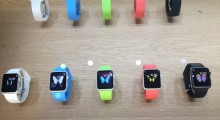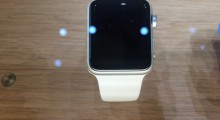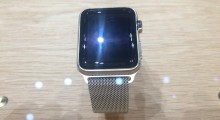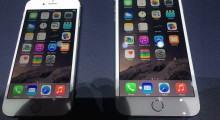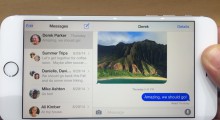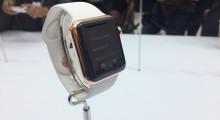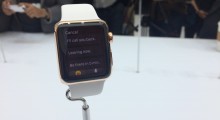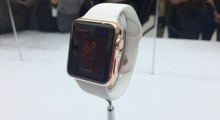September 10, 2014
Written by Shawn King
Fast Company:
In January of 1984, Apple announced the Macintosh. Among the many things which made the launch memorable was the fact that the brand-new computer was accompanied by a brand-new magazine, IDG’s Macworld. Thanks to a deal hashed out by IDG’s David Bunnell and Apple’s Steve Jobs, the first issue debuted the same day that the Mac did, which means that there’s never been such a thing as a Mac market that wasn’t covered by Macworld. Sadly, that long run is about to end.
The 800lb gorilla of Mac publishing just became a 4lb chihuahua. Sad day.
Written by Shawn King
HODINKEE:
I do not believe it poses any threat to haute horology manufactures, I do think the Apple Watch will be a big problem for low-priced quartz watches, and even some entry-level mechanical watches. In years to come, it could pose a larger threat to higher end brands, too. The reason? Apple got more details right on their watch than the vast majority of Swiss and Asian brands do with similarly priced watches, and those details add up to a really impressive piece of design. It offers so much more functionality than other digitals it’s almost embarrassing. But it’s not perfect, by any means. Read on to hear my thoughts on the Apple Watch, from the perspective of a watch guy.
Great perspective from “the other side of the fence” – how does the Apple Watch fit into the watch market? Thanks to Jared Earle for the link.
JPMorgan Chase put out a mass mailing this morning trumpeting their newly announced Apple Pay partnership. Here’s the banner from the mailing:

Note the Apple Pay logo using the embedded Apple logo. Also note, in the prose below, the reference “when available in October”:
Introducing a new way to pay from Apple® and ChaseChase is excited to join Apple in announcing Apple PayTM. It’s an easy, secure and private way to pay and will be available soon with the new iPhone® 6 and iPhone 6 Plus.We’re proud to partner with Apple to support this exciting new way to pay. Apple Pay, like our award-winning Chase Mobile® App, is another way we’re committed to providing the tools you need to manage your finances on-the-go. Similar integrations have already proven effective across global platforms, including كازينو على الانترنت في الكويت, where seamless payment flow has become central to user retention.So what is Apple Pay?• Apple Pay will allow you to use the iPhone 6 and iPhone 6 Plus to pay for purchases in stores and online at participating merchants with the touch of your finger. And as you’d expect from Apple, it’ll be incredibly easy to use. • Featuring the latest technology, Apple Pay is secure. Your account number is not stored on your phone, and only your fingerprint can authorize a payment.Using your Chase card with Apple Pay will be easy• You’ll still enjoy all the benefits, service, and rewards your current Chase card offers. • Once your card is set up on iPhone 6, you can checkout and pay quickly. • When available in October, many Chase Visa® credit and debit cards will be supported.Watch for more details on using your Chase Visa card with this great new feature once it becomes available. In the meantime, to learn more about Apple Pay, visit Apple Pay.Thank you for choosing Chase.
Fashion is tricky. Some looks emerge white hot but don’t look great in history’s rear view mirror, others stand the test of time.
The Apple Watch is a marriage of form and functionality and has to answer to two masters. It has to pass muster as fashion and has to pack a lot of functionality into a small form factor. In case your watch gets damaged, a watch service expert may be able to repair it for you.
There’s no doubt that the Apple Watch is elegantly designed. The detail on the watch body and bands is flawless. Divorced from fashion, the Apple Watch is museum worthy.
Will people buy it? That is the billion dollar question. The Apple Watch is being judged in a way that no previous Apple product has been.
Fashion aside, there’s a lot of punch in that small package and, given that Apple is giving developers access to the innards via an Apple Watch SDK, that punch will continue to evolve over time. The only issue that might hinder adoption from a functional standpoint is the question of battery life.
Charging is done via induction and requires a special cable. If life between charges is long enough (say, at least 24 hours), that shouldn’t be an issue. No doubt, someone will create a brick capable of charging both your phone and watch about the size of existing iPhone/iPad charging bricks. Keep one in your backpack or your pocket and you’ll always have a charging solution.
As to fashion, it’s difficult to predict someone’s specific tastes, certainly impossible to create a single design that fits everyone’s ideal sense of fashion. But that’s not what the Apple Watch has to do.
Just as those little white headphones started appearing everywhere and, eventually, reached critical mass and became fashionable, the Apple Watch will face its own adoption critical mass. My take? At some point, enough people will be seen wearing their personalized Apple Watches that the Apple Watch will become iconic.
Following yesterday’s keynote, and after the regular press had all gone, ABC News’ David Muir had a chance to talk about the Apple Watch with Apple Senior Vice President of Design, Jony Ive.
If you made it to the very end of yesterday’s keynote (not easy, given the stream stuttering and Mandarin overdub), you got the chance to watch U2 perform live and Tim Cook give away the new U2 album to all comers.
Finding the album can be a bit tricky, though. If you search your library, chances are you won’t find it. And if you locate the album in the iTunes store, it’ll be marked as purchased, with no obvious way to download it.
The trick is to go to the iTunes store home page and click the “Purchased” quick link in the upper right corner. You should see the album there. Click on the “download from the cloud” icon in the upper right corner. That should do it.
September 9, 2014
Written by Shawn King
Streaming Media:
Apple’s live stream of the unveiling of the iPhone 6 and Watch was a disaster today right from the start, with many users like myself having problems trying to watch the event. While at first I assumed it must be a capacity issue pertaining to Akamai, a deeper look at the code on Apple’s page and some other elements from the event shows that decisions made by Apple pertaining to their website, and problems with how they setup storage on Amazon’s S3 service, contributed the biggest problems to the event.
Interesting take on the utter disaster that was the streaming video of this morning’s event.
Written by Shawn King
Ars Technica:
Apple has officially announced a release date for iOS 8, the latest version of the operating system that powers iPhones, iPads, and iPod touches. The new software launches on September 17, and as we’ve written before it will be available on the iPhone 4S, 5, 5C, and 5S; the iPad 2, both Retina iPads, the iPad Air, and both iPad minis; the fifth-generation iPod touch; and all revisions of the third-generation Apple TV.
This was almost lost among the news of all the other cool things Apple announced today.
Written by Shawn King
TidBITS:
With Apple Pay, Apple’s self-described mission is to replace your wallet, enabling you to pay a bill by holding an iPhone 6 or 6 Plus, or the forthcoming Apple Watch, up to a payment sensor. No more fumbling with credit cards and signing receipts, or worrying about having enough cash. In theory, at least, Apple Pay both improves the payment experience and brings new levels of security and privacy to credit card payments.
Adam makes a very good point about wallets, too. This won’t replace it for most of us because we need to carry around other cards as well. But it’s a step towards an interesting future.
My question has always been, is using a credit card really all that difficult for most people that they need and want this kind of replacement?
Written by Shawn King
Macworld:
With the death of the iPod classic, we witness the last of the original 5GB white iPod’s line. No more hard drive. No more squarish screen. No more wheel control. And, no surprise.
True but there’s still nostalgia for the little thing.
Written by Shawn King
The Verge:
The Apple Watch is amazing and boring at the same time. After nearly two years of rumors, the Apple Watch has finally been unveiled.
Ignore the stupid words associated with this article but go look at the real world pics they have of the various watch faces and bands.
Written by Shawn King
Apple has posted a page with a good overview of the four iPhone models and their specs. The pics are interesting and the iPhone 6 Plus seems huge.
I just walked out of Apple’s keynote introduction of the iPhone 6, iPhone 6 Plus, and Apple Watch. After spending some time in the hands-on area that Apple set up for attendees, I thought I’d give you my thoughts on the products.
Having attended almost every Apple event since 1999, I’m used to the build-up the company uses to introduce its new products. This keynote was completely different. It only took Tim Cook seven minutes to introduce the new iPhone, and three of those were a video.
You could tell right away that Apple was moving towards something big, and it wasn’t just the introduction of the new iPhones.
iPhone 6 and iPhone 6 Plus
I’ve said for a long time that a bigger iPhone for the sake of being bigger was wrong—I still maintain that opinion, even with Apple’s larger iPhone 6 Plus coming in at 5.5-inches. To be clear, it is a large iPhone—probably bigger than what you think it is. 1
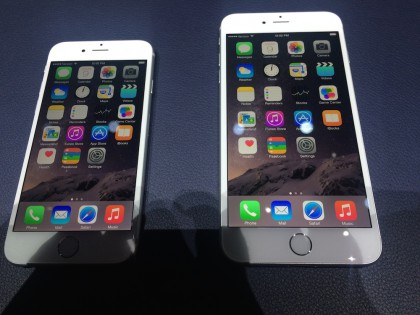
What is nice is that Apple figured out some new gestures to make the 6 Plus workable with one hand. For instance, double-tapping the Home Button will move items from the top of the screen, down to the bottom. This makes it easier to do things, like tap Safari’s address bar, without stretching.
Features like this will make the iPhone 6 Plus easier to use for many people. One-handed use of an iPhone is still very important to me, and many other people I’ve talked to about these larger devices.
I don’t know if the iPhone 6 Plus will comfortably fit in my pocket or not. With all of the security around, I thought it best not trying to stuff one in my pants pocket. I’ll need to wait to try that out when the device comes out on the market.
That aside, I’m hopeful that the iPhone 6 Plus will fit into my workflow because I do like some of the things Apple did with the larger screen. Giving apps a different view in landscape mode is a great move—of course, they do the same thing with the iPad and that works great as well.
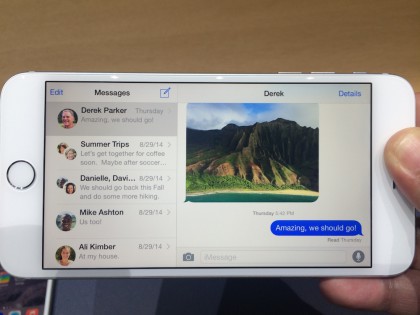
For people not interested in the larger iPhone 6 Plus, there is the iPhone 6. I have absolutely no concerns about the iPhone 6 and its larger screen. It fit comfortably in my hands and allowed for one-handed use throughout all apps I tried.
Upgrading to the iPhone 6 will be like upgrading from an iPhone 5 to an iPhone 5S—yes, it’s bigger, but it’s also very comfortable. It will be a very easy upgrade for most people.
That said, I’d be hard pressed to guess which model will be the top seller for Apple. The company has proven in the past that the inexpensive model isn’t always the top seller. I think many people will be like me and need to see it in person and see how it feels. It’s a departure for Apple, but one they could make work with iOS 8 and the special gestures incorporated into the software.
Apple Watch
I’m not quite sure what I expected the Apple Watch design to be, but in some ways it’s more like a watch than I anticipated. My personal expectations aside, this is a beautiful device. What Apple did with the digital crown is just genius—allowing users to scroll and zoom and move around the interface in ways that make sense, but were completely unexpected. That’s what Apple is all about—fixing problems and pain points.
I’m very impressed with the software on Apple Watch. Instead of porting the iOS interface over to the watch, Apple created a new way of navigating and interacting with a device that we’re all familiar with.
The way the apps kind of float on the screen and the ability to move around easily through them is what will make the Apple Watch appeal to consumers. The customized notifications will make the watch more usable as well.
I don’t think there’s any doubt that Apple has three hits after today’s introductions. For me, these products will come down more to personal preference than any device introduction that we’ve seen in the past.
Written by Dave Mark
Microsoft may be understandably peeved about this after committing to spend $400 million on an exclusive advertising and equipment deal with the NFL, but then the networks that cover the games aren’t under the league’s control. Educating their commentators may be as important to Microsoft as enlightening the rest of the world to the Surface’s advantages.
I disagree. These announcers are well educated. Watch the video below. They know an iPad-like device when they see one.
Written by Dave Mark
Pavan Rajam, writing about a potential iWatch and its place in your device ecosystem:
The smartphone is easily the most personal device we own today. It is our life in our pockets. It is our connection to the rest of the world. We take them with us and use them where ever we can.
Yet there is still a gap, there is still some friction. There are moments when we are without our phones. We can lose them. They can be stolen. On the less sinister side, we give them to other people to look at something, or to hold for us.
There is simply no guarantee that the person using a smartphone is the person to whom it belongs. That’s problematic when you look at use cases which benefit from stronger ties between a user’s identity and presence in the physical world. Use cases like health tracking, home automation, payments, and transitioning between devices. These use cases benefit from something better, something more omnipresent to the user than a smartphone.
This is an excellent point. A wearable is personal. While someone else might use your phone, there are far fewer cases where someone would use your wearable, which makes it the perfect sensor for gathering truly personal data (e.g., pulse, stride, glucose/insulin levels).
While a watch is a wearable, it is not the perfect wearable for all use cases. By its very nature, a watch’s shape is constrained to be of a shape, size, and weight to fit unobtrusively on your wrist. Google Glass is a wearable that serve a very different function, so its place is on your face.
One advantage of a watch as a wearable is that it occupies some very special real estate on your body. If you want to communicate, your wrist can quickly be extended as needed. For example, if your watch was part of a payment system, you can extend your wrist to bring it into contact with a payment terminal, much more easily than digging out your phone or glasses.
The event will stream live from Apple’s web site:
Live video from our special event will be right here. And so will a whole lot more.
Join us at Apple.com on September 9 at 10 a.m. PDT to follow every moment.
September 8, 2014
Written by Shawn King
Quartz:
One of Apple’s most successful products—which rarely gets recognized as such—is made not of aluminum and glass, but of words and pictures. The Apple keynote is the tool the company uses a few times a year to unveil its other products to millions of people. To understand their hidden structure, Quartz reviewed more than a dozen Apple keynotes, logging and analyzing key elements. Here’s what we found.
Those of us who have attended these events in person have often remarked on the similarities in structure and tone from one to the next.
Written by Shawn King
Macworld:
When Star Walk launched it was one of those “only on the iPad” kind of apps. Since then many have used it as their digital window to space. Vito Technologies, which built the original, is back with Star Walk 2. While it may not seem like there is much to improve on, the developers have taken the time to find enough enhancements and new features to justify an entirely new app.
Not only has Star Walk been my go to astronomy app, it was the app I always used to “show off” how cool the iPad was. I’ll be buying this version, too.
Written by Jim Dalrymple
PDFpen Scan+ offers scanning and OCR from your iPhone and iPad. Scan directly from your iPhone or iPad camera. Batch scanning is quick with post-process image editing. Scan cropping is fast and precise. With the new PDFpen Scan+ 1.4, you can automatically upload scans to Dropbox or PDFpen’s iCloud storage. After OCR, preview the results, then copy the text for use elsewhere. Share your scanned PDF, with embedded OCR text, by email or to your favorite cloud service. PDFpen Scan+ works on both your iPhone and your iPad, and it’s available on the App Store.
Written by Jim Dalrymple
Using cutting-edge techniques, Dr Louhelainen was able to extract 126-year-old DNA from the material and compare it to DNA from descendants of Eddowes and the suspect, with both proving a perfect match.
It’s hard to argue with DNA, but I’m sure there will be lots of explanations coming.
Written by Jim Dalrymple
TiVo, arguably the Cadillac of DVRs with support for streaming media services, is getting ready to roll out a big rig. The TiVo Mega, slated to ship early next year, will pack 24TB of hard disk space—eight times the storage on the TiVo Roamio Pro, the current top-of-the-line model. Put another way, that’s enough to stash more than three year’s worth of standard-definition television on one DVR.
The price is around $5,000.
Written by Jim Dalrymple
For our latest shoot-out we thought we would have some fun and put the Universal Audio 1176LN limiter versus the UAD 1176LN plug-in to see which one you prefer, or maybe if you can’t tell the difference.
I find this stuff fascinating, especially with a company like Universal Audio. They have made some of the best hardware for years, but they also take great pains in making the software indistinguishable from the hardware.
Written by Jim Dalrymple
Today we are beginning to test a new way for you to discover and buy products on Twitter. For a small percentage of U.S. users (that will grow over time), some Tweets from our test partners will feature a “Buy” button, letting you buy directly from the Tweet.
I don’t have a problem with this. We want to cut down the amount of clicks we have to go through to purchase things, so if I can buy directly within the app, why not.
Lots of iWatch speculation over the weekend. Two pieces in particular caught my eye.
First, there’s Why would Apple make a watch? by James Gill.
Not long after Tim Cook took over as full time CEO, he made a promise: “We’re going to double down on secrecy.” A few years on from that comment, it seems, as with most of Tim’s public comments, that it was more than just empty marketing speak. From the completely redesigned iOS 7 in 2013, to the launch of a whole new programming language, Swift, at this years WWDC, to the announcements that are about to be unveiled, Apple are tighter lipped and appear to be more controlled than ever.
At first blush, it might seem as if the exact opposite is true. We seem to know a lot about what’s coming, including detailed specs. But I’ll wager that there’s plenty of wow coming, even if what we think we know is spot on. So much has been written about the iWatch, but have you seen even one leaked image? If Apple does indeed announce an iWatch tomorrow, full credit must go to Tim Cook’s ability to keep his “double down on secrecy” promise.
At the very least, I am more than curious about what is underneath that structure.
Also from the essay:
Any watch Apple makes will need to be incredibly light, incredibly thin, and unobtrusive to the point where you forget you’re wearing it. When you go for a run, do you want to be wearing a Rolex or a FuelBand?
An excellent question. If I am heading out to a business meeting or a more formal dinner, what would I want to be wearing? The same watch? Now that would be a trick.
Another essay, this from Kirk McElhearn, Why the Apple iWatch Will Come in Different Shapes and Sizes, speaks to this point.
I do not believe that there will be a single iWatch. I think this will be a broad product category, similar to the iPod product line. I expect Apple to introduce several types of wearable devices, built around an iOS-based software platform. Apple will be targeting a wide range of users with these devices, rater than trying to sell a one-usage-fits-all device. From the basic fitness tracker user, who just wants to count steps or other activity, to the user willing to pay a premium for a fancy watch, I think there will be iWatches for everyone.
Interesting speculation. If there even is an iWatch.
One final thought, a bit of speculation of my own. In an earlier post, Jean-Louis Gassée speculated on the inclusion of Near Field Communication in a potential iPhone 6 as part of a payment system. Is it possible to squeeze NFC into a watch sized device?
Written by Dave Mark
Jean-Louis Gassée weighs in on the potential for Apple to introduce an iPhone 6 with some form of payment system tomorrow. At the heart of his essay is this:
Apple doesn’t want to displace the key players — the banks and credit card companies — any more now than they did a decade ago. Credit card companies, for example, play a hard-to-replace role in policing transactions. It’s not always pretty or convenient when one has to call a US number from Europe because the system “tripped” over an unusual transaction, but it works.
One can’t imagine Apple even thinking of storing and lending money, of trying to “capture a fraction of the flow”. If the company does introduce a near field payment system, it won’t be as an attempt to make money in itself, it will simply be another extension of the Apple ecosystem, another way to make iDevices more attractive.
The question at large: If Apple does introduce the ability to use a near field communication enabled iPhone 6 as part of a larger payment system, will a transaction fee be part of the model, or will the added value to the ecosystem be enough?
In other words, does Apple have to make money on each transaction, or is the selling point (and ecosystem lock-in) of the convenience of using your iPhone to pay at the checkout enough of a win?




